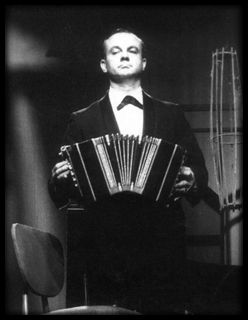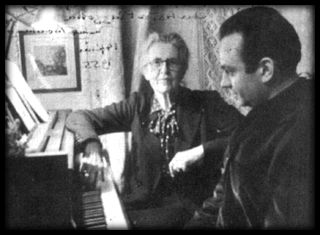By
Piazzolla in France. Always Paris, adieu Paris.

ue to a scholarship of the Paris Conservatory and fed up with the lack of opportunities in his country, he traveled to France. But when already based in Paris he decided to resign the scholarship and study instead with the renowned musicologist Nadia Boulanger. As his tango pieces published by Julio Korn had been widely spread successfully, the popular orchestras of France already knew them. But to protect the local musicians there were restrictive regulations which did not allow him to play in public places, so he only had the chance to play at recording sessions. For that reason, with the help of Yves Baquet, director of Editions Universelles, a publishing company authorized to distribute his works in France, and Marcel Feijóo, a prestigious leader of a French tango orchestra, he managed to record in 1955 a series of tangos in two 10-inch LPs with members of the Opera of Paris Orchestra and the jazz pianist Martial Solal.
 Even though in some of them the effect of uprooting may be noticed, since they were written in Paris, the beauty of the musical construction stands out. The level of the performers is excellent, especially the bandoneon lines played by the leader and arranger, that here is the main soloist with a background of strings, harp and piano. In this context, Piazzolla works with a rhythmic, melodic and harmonic freedom never known before in tango music.
Even though in some of them the effect of uprooting may be noticed, since they were written in Paris, the beauty of the musical construction stands out. The level of the performers is excellent, especially the bandoneon lines played by the leader and arranger, that here is the main soloist with a background of strings, harp and piano. In this context, Piazzolla works with a rhythmic, melodic and harmonic freedom never known before in tango music.
The numbers recorded then were “Nonino” (a tango dedicated to his father containing a first rhythmical part with marked danceable features and a second part with lyrical and melancholic overtones), “Chau París”, “Tzigane Tango” (on request of the lead violin of the French orchestra that accompanied him at that recording he wrote it for showcasing this soloist), “Bandó” (name given in France to the bandoneon), “Prepárense” (one of the first tangos that Piazzolla composed in this innovative style and which became very popular in France), “Guardia nueva”, “Contrastes”, “Marrón y azul”, “Río Sena”, “Luz y sombra”, whose melody brings back memories of “De vuelta al bulín”, the everlasting tango written in 1914 by the pianist José Martínez, “Sens unique” (the one-way traffic, common in Paris, it was not yet like that in Buenos Aires), “Picasso”, “Estamos listos” and “Mi tentación”, all composed by him except the last two, while “S.V.P.” was also signed by Feijóo. Here nearly all the material is indispensable.
After the new creative cycle opened in 1950 with “Para lucirse”, Astor evidenced that the flow of his inspiration had not been halted by distance. When he came back from Paris he put together a string orchestra. At the front line of a qualified group of instrumentalists he included the legendary tango violinist Elvino Vardaro. For the TK label he recorded a 78 rpm disc (a then already obsolete device which was being replaced by the new vinyl long-playing record) containing the Pugliese’s advanced tango “Negracha”, clearly avant-garde, and the milonga “Azabache” with Jorge Sobral on vocals. These pieces were not reissued either.

Because of the scarce interest of the local recording companies in releasing his music he recorded in Montevideo an excellent 10-inch LP for the Sondor label with this same line-up. Among the instrumentals it is —maybe— his first rendition of “Lo que vendrá”, notable for the way in which he manages to blend modernity with respect towards the genre. It is included, as well, a tango composed by Vardaro, “Miedo”, in which we can enjoy, due to Piazzolla’s arrangement, the quality as violin player of this recognized artist of our city music, who was one of the greatest players of that instrument in the history of tango.
The other numbers included were “Sensiblero”, “Tres minutos con la realidad” (a composition by Astor that at that time meant a scandal for traditionalists because they were unable to assimilate it to already known standards, unless the latter were outside the genre, that is to say, classical music, and in this case, Béla Bartók) and “La cachila”. It was the first time that Piazzolla recorded a composition by Arolas, a bandoneonist and genial composer who died in Paris in 1924. Astor had dedicated to him a tango of eloquent title: “Juan Sebastián Arolas”, probably implying the importance of Arolas in tango in comparison to Bach. That piece was arranged by Piazzolla for his 1946 orchestra but he never played it.
The vocal numbers of the Sondor record were the candombe “Yo soy el negro”, by Piazzolla and the writer and playwright Carlos Gorostiza, and the tango “La tarde del adiós” in which the orchestra provides a background for the nice male sound of Jorge Sobral's voice. But it is in this second piece of beautiful conception where Piazzolla, after Sobral's first appearance, delights us with an anthological bandoneon solo in which he wisely combines his amazing technique and his creative fantasy to embellish the original composition.
From: Astor Piazzolla El tango culminante, by Julio Nudler, Aldo Delhor y Laureano Fernández, Editorial La Página S.A., Buenos Aires, 2001.